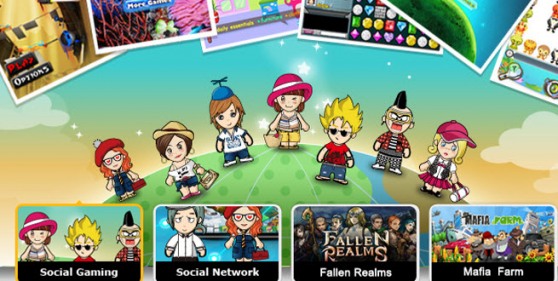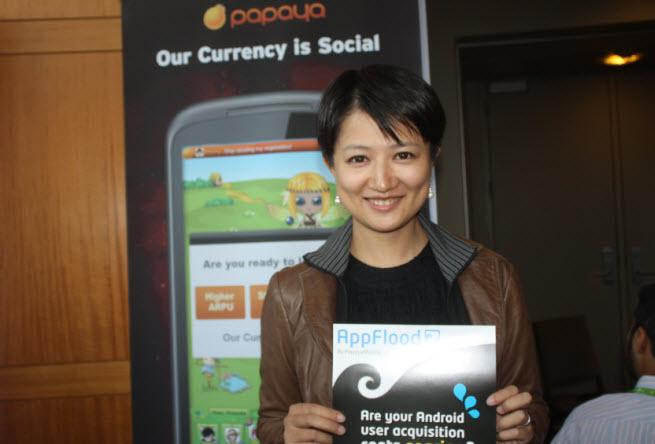Si Shen is the chief executive and cofounder of Papaya Mobile, a mobile social gaming network based in Beijing, China. The company’s customers have more than 65 million mobile game users in a network for social game-sharing and cross-promotion. Most of those users are in the U.S., and all of them are on the fast-growing Google Android operating system.
Recently, Papaya Mobile launched AppFlood, a mobile traffic exchange that lets game developers advertise to the users of other games at no cost. The developer who shows another game to a user — and gets that user to install that new game — will get a credit. In turn, the developer can use that credit to advertise for free through other developers on the exchange. It’s a way to grow Papaya’s network, and it helps gamemakers deal with the high cost of user acquisition. By making itself useful, Papaya Mobile will become more and more critical to the developers it serves, Shen said.
We caught up with her at the recent Casual Connect game conference in Seattle. Here’s a transcript of our interview with Shen.
 GamesBeat: What’s new? What are you most busy with right now?
GamesBeat: What’s new? What are you most busy with right now?
Si Shen: We released AppFlood. It’s very interesting because you know what we do. We’re a social gaming network. But mostly we work with smaller social games, which are actually quite a small part of the market. When we’re talking to larger social game companies like TinyCo, they tend to have their own smart network for users. So they tend not to use a third-party social gaming network.
But they also came to us earlier this year, saying they are doing direct deals with developers to exchange traffic. They asked if they can do it with us. We have our own games and we have developers, so we struck a deal with a developer, and it turned out that it’s actually not very efficient to do this kind of deal, even though everybody’s doing it right now. You have to negotiate terms first, and then it took us three weeks to do the implementation. Then we could start to do the exchange. Usually it has sizable traffic back and forth for probably two weeks, and after that you don’t see much traffic. That’s because users have seen all the games already. Then you have to start to strike deals with another developer.
Then they said, “If everyone is doing this, why don’t we have a network where we can exchange traffic with each other?” We said, “OK,” since we’re making a platform and people like this idea, and there’s definitely a huge need in the Android market right now. It’s so fragmented. There’s a lot of friction. It costs a lot to buy traffic. So why don’t we just exchange traffic? A lot of people still have extra traffic. So we made this platform and released it a couple of weeks ago.
What it does is if you give one install to this network, you get one credit. If the network gives you one install, one credit gets taken away. Very simple, right? And then you collect credit. The more you have, the higher the frequency with which you’ll be shown in other people’s games. This works for a lot of non-game applications too, so we work with them, as well. When we released it, several big game developers and app developers were already signed up with us. They’re doing the integration right now. Like Pocket Gems — that’s one that already started doing it, and one that I can talk about.
Dolphin Browser — they’re going to release it very soon. There are several others that I can’t talk about yet. Casual games get a lot of traffic and a lot of credit. They can sell that in the control panel. Say I have 5,000 credits, and I want to sell it for such and such a price. If somebody likes that, they’ll say, “Sure, I’ll buy that from you,” and it’s a direct transaction. We don’t take any cut. We’re trying very hard to reduce the friction in this market. If it can benefit everybody, it will benefit the games we’re working on right now, too. Besides the initial traffic that we give from the network to these small social games, they can also get a continuous stream of traffic from the whole system.
GamesBeat: And then you eventually make money if your developers are successful.
Shen: Yeah. Everybody wins. Actually, after we released the product, we found out that people use it in another way. A lot of developers have good casual games, and they’re making high ARPPU [editor’s note: average revenue per paying user] games. Games have a different life cycle. Usually they have very popular games right now, but maybe after several months or half a year, when they have a high ARPPU game, their current games are not popular anymore.
Previously, what they were doing was selling traffic on these popular casual games. But whenever they sold it, 30 percent went to whoever runs that network. And later, when they have this high ARPPU game, they’d use the money to buy more traffic, and they’d pay 30 percent on that again. So from these two transactions, more than 50 percent came off the top. Now, what they’re doing is they use the casual games to collect all their credits. Then, using the AppFlood system, they can transfer credit around all those applications and games. They can transfer all the credit they collected to the new game that they’re going to release. Later, when they release a new game, they can drive all the traffic they need to this one game. They love doing that. A lot of people are collecting credits right now.
 GamesBeat: Are they just collecting them to use at some future date?
GamesBeat: Are they just collecting them to use at some future date?
Shen: Not exactly. It’s because those are basically installs. It’s a real install credit.
GamesBeat: So they stockpile credits and stockpile installs for the future when they need them.
Shen: Right. It’s like the system owes you this much credit. You move it to another application or game, so later, when you turn it on, then the system starts to drive traffic to this new game. From all these transactions, there’s no loss or cut that’s taken from other people. They love this idea.
GamesBeat: Is it like Tapjoy or Chartboost — something like that? Chartboost has a developer exchange going, right? But there’s a part that they do charge for.
Shen: Chartboost is actually quite different. Sometimes people ask us, “What’s the difference?” Chartboost has a direct exchange tool, which is what I was talking about before. If I want to strike a deal with you, I use the Chartboost tool so we can do it 1-to-1. But after we’re done, I have to find another person and strike a deal with them. It’s basically 1-to-1. It’s not a network.
So Chartboost’s idea is that people use their tools — the direct exchange tools — for free. But at the end of the day, they won’t be able to get enough traffic, or they won’t be able to exchange all of their traffic, so they turn to Chartboost’s ad network. It’s very similar to AdMob or Tapjoy. It’s an incentivized ad network. So very similar to Tapjoy. From that, Chartboost is taking a cut.
[Chartboost’s Maria Alegre corrected the record. She said Charboost is not incentivizing users. It is not doing only direct deals but is also a network; and she says that Chartboost has enough traffic with 2 billion user sessions a month.]
So they’re totally different from what we’re doing. Although I’m exchanging with everybody, I have a blacklist. I can say, “I only want to exchange with these people.” By doing that, we can essentially enable 1-to-1 exchanges. You can just blacklist all the others. Say I struck a deal with you, but we’re plugged in on AppFlood. We can just blacklist everyone else and have each other left. Then we’re doing a direct exchange. I can turn that on or toff whenever I want. It’s very convenient. We didn’t even know people would do it like that. For instance, we have several Scandinavian developers, and they usually just exchange traffic with each other. So what they do is they’re going to use AppFlood, and they blacklist all the others. They’ve formed a little cluster, and they only exchange traffic within the cluster.
GamesBeat: It’s interesting, but it’s also complicated. I keep thinking about how complicated this business gets overall.
Shen: People are exchanging traffic, anyway.
GamesBeat: And it’s all because they don’t want to spend this money on marketing or third-party marketing services.
Shen: It’s expensive, yeah. People aren’t making a lot of money on Android.
GamesBeat: What winds up being — out of all the things you guys offer — the way you make most of your money? Is it still just helping people socialize their games?
Shen: Yeah. It’s in line with what we were doing. We are still doing the social part. It’s basically just another arm of what we’re doing. It’s connected because if a social game comes to us, they’ll use both. The Social SDK and AppFlood SDK. Or if someone just comes for Social SDK and they’ve heard about AppFlood, they’ll say, “Oh, this is a good idea. We’ll do it.” The other thing we’re going to do is…because we have more information about users — their social information — through Papaya…we can do much better targeting based on the social graph for AppFlood. AppFlood is just launched, so it still needs to pick up. But after that — after we have the scale — we’ll start to do more social targeting. Which is a core competence we have, and most of the others don’t. We have the data.

